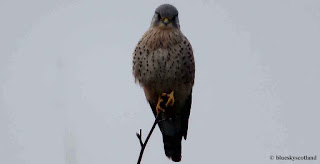Photo taken near Anne's house. The Campsie Fells and Bearsden from High Knightswood. Looking for someplace different to walk locally a couple of weeks ago at the start of what appears to be one of the sunniest, driest April months on record in Central Scotland I thought I would start near Westerton Train Station. This would allow me to climb several of the cities many drumlins ( small hills) at once and also visit a place I had never properly explored. Some of the remaining fragments of the once impressive but private Garscube Estate that used to run between the Campsie Fells seen above, through Bearsden, also seen above, to the Glasgow outskirts.
River Kelvin Gorge. Garscube Estate.This takes in both banks of the River Kelvin, Dawsholm Park, The West of Scotland Science Park, The Vet School, The University of Glasgow ( Kelvin Campus) and several other areas.
As it's been very dry and sunny all this month since the start of April it was another perfect blue sky day. 24 of them so far in a row and no rain in sight. Unwatered gardens are now dying and thirsty. Lawns are turning brown in the heat. Popular car parks are usually packed out every day, unless you get up very early... which is why I ended up here. Peaceful and quiet. Just me and nature. As always.
Glasgow. Another perfect day in earthly heaven thanks to the UK's (4th or 5th depending which online stats you read) largest city which is situated in a bowl, mostly covered in concrete, and so burns off clouds better than the outlying countryside can. A micro climate effect I've seen in action many times over the decades with an often perfect circle of blue appearing over the built up districts doughnut- any clouds pushed back to the very edge of the ring of encircling hills. There the sky-scapes, (with an encircling landmass rising between 500 to almost 2000 feet) gather and hold onto any clouds while the central city depression, at around sea level, disperses them. Another reason I love cities. Good thermals within them to punch a hole.
Since the start of this blog thirteen years ago I've noticed many other blue sky titles appearing but they usually mean something entirely different from this one. For me it's still one pure unadulterated love affair. The rush I always get waking up to a perfect blue sky day- often completely unsullied in the morning or with a few fluffy clouds drifting across it by afternoon. To the extent where, in my free time, I'm reluctant to explore outdoors in anything else. Hence the name of the blog. Still does what it says on the tin/label. If it's grey- no way.
A sea of golden daffodils for a creature made up entirely of honey and sunshine, on this particular morning anyway... i.e... me.
The simple beauty of a small stream in Springtime.
The sparkling path through the woodland realm of Knights.
The magical colours and scents of Spring.
Cherry Blossom. A perfumed garden.
The old man of the woods.
A young bear. Garscube Estate.
Tree creature.
Putting the bears in Bears-den.
Various drumlin views from districts ending in.... hill. Anniesland and the green spires of Jordan-hill College.
Blairdardie, Drumchapel Hi Rise Flats, ( white with blue stripe) and Clydebank Hi Rise clusters. Drumry and Radnor Park groups) Distance views somewhat hazy by this time. Afternoon now.
Climbing yet another drumlin. Small but still tough after a few completed already on a warm to hot day.
The Kilpatrick Hills view. Not a drumlin but an encircling city range.
Part of High Knightswood district. Yep! Another drumlin by the looks of it.
Heading for Drumlin no 3 . Gilshochill/Maryhill District.
The white towers. Lincoln, Kingsway, high rise clusters in a line.
....and then back to Westerton Train Station on the Forth and Clyde Canal. Note the clouds over the Campsie Fells here, a long wall of cliffs close to 2000 feet high yet clear blue sky directly above, over the city. High ground creates its own weather system/ micro climate, along with rivers, woods and sea. At certain times of year it can be sunny inland yet misty/foggy at the coast or lingering mist pockets along river valleys, deep hollows, or woods that take ages to burn off- all due to temperature differences or upward/downward thermals of a few degrees. Something that glider pilots and large birds take full advantage of... soaring higher over certain fields that give off heat, sinking lower over woods, marsh, and river.
Chow down time. Chicken, turnip, potatoes, carrot, onion, tomatoes. Various spices. Lovely stuff.
Link to Garscube House and old estate photos. 1954 photo.
https://www.theglasgowstory.com/image/?inum=TGSD00265















































